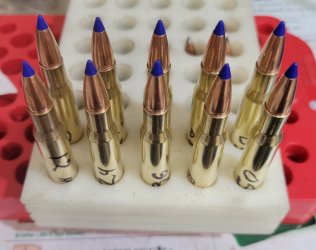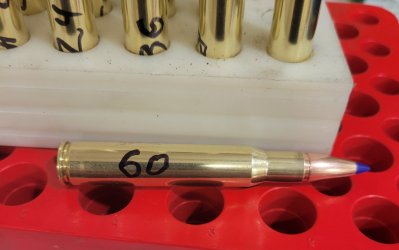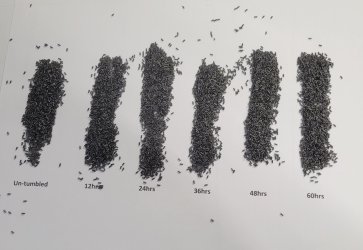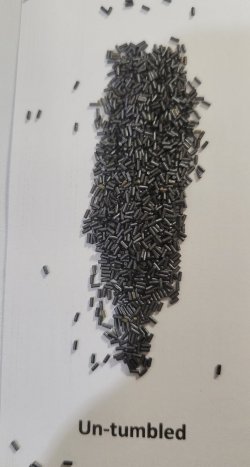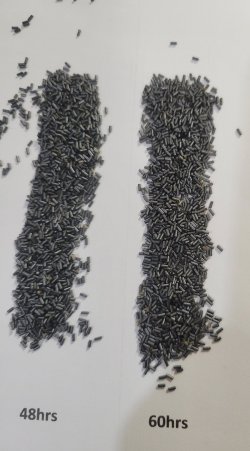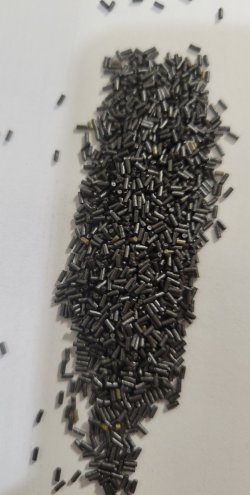I read a lot of blogs about reloading, always want to learn more and new things people have discovered. Sometimes I read things that just make me shake my head and go "HUH?" Like the guy on a CA blog claiming he is getting 4300 fps from his 223 AI shooting 55 grain pills and hitting PDs at 800 yards consistently. Yup, got to try his load.
The following is not meant as an attack on anyone, it is only to make people think about the un-intended consequences when reloading ammo.
Awhile back I read a post from a careless reloader. He posted a picture bragging about how shiny and clean his reloads looked after tumbling for over 20 hours. He stated the ammo was put in the tumbler one evening and he forgot about it. When he got home from work the next day, he discovered they had be running for excess of 20 hours. Eek!
I immediately posted my response: DO NOT SHOOT THAT AMMO UNDER ANY CIRCUMSTANCES! I gave him a brief explanation about the danger. Man did I get grief!
Responses ranged from: I've been doing that for years! Ammo manufactures tumble their loaded ammo! You don't know what you are talking about. ETC.
My answers to these responses were: If you have been doing this for years, you are very lucky and I'm pretty sure you accuracy was not impressive. Ammo manufactures do not tumble; they use vibratory systems for a very short time. I think I am a pretty knowledgeable reloader, been doing it since I was 14, 70 now.
For the last couple of months, this has been weighing on my mind and decided to expand on my explanation to him with an experiment to show what can happen by tumbling loaded ammo. This is in the hopes that no one else will do this.
This is second hand from a fellow shooter that does not lie or exaggerate. His father purchased some cheap reloaded 243 ammo for his 788 Remington (one of the strongest actions at the time) at a gun show. He too was impressed by how shinny it was.
First round that was fired, destroyed the gun. Bulged the action and barrel to the point they couldn't pull the barrel, had to be machined out. Bolt was seized in the action; stock was split, scope mount blown off, etc. His father was lucky he didn't get the bolt in his face. Had it been a lessor gun, he probably would have received some major injuries beyond the face burns he got. What happened? . He's trying to find the pictures of the gun, been about 10 years ago
When they got home and pulled some of the bullets to attempt to determine what powder was used. They discovered the powder was no longer granular, it was DUST!
I personally witnessed a 270 win destroyed by ammo loaded with ball powder left sitting in the sun on a hot day, not pretty. To this day, I avoid ball powder.
So I decided to run a small experiment to show what happens to powder in this scenario. First I don't think there is any danger of a round going off, primer takes a lot harder impact to set it off.
I placed 10 rounds of '06 loaded with IMR 4064 that was loaded about a month ago in a tumbler with crushed walnut hull. I pulled 2 rounds out at 12 hour increments. Each round was marked with the number of hours they had been tumbled.
After 2 ½ days (60 hours) of tumbling, 1 round from each time period had the bullets pulled using a collet puller and the powder dumped out on white paper along with the powder from one round that had not been tumbled. All rounds were from the same batch.
I did not get the same result of dust, but I did find the kernels were slightly different color at each increment. The biggest thing I found was the powder was impacted together tighter with each increment. The un-tumbled powder poured out cleanly; at 12 hours I had to give it light tap to dump it out. After 24 hours, I had to use a small screw driver to dislodge the powder as it was packed in hard. At 60 hour, I had to dig the powder out .
It's hard to see from the attached photos the difference in the powder, but I could see a difference between each increment. I did see some small flakes that looked coating coming off? I believe as the powder kernels rubbed against each other, they slowly changed. It doesn't take much to understand/realize how this drastically changed the burn characteristics.
I then poured powder from the remaining 5 rounds plus one un-tumbled round onto a board. To show the difference, they were lit, WOW! I tried to video the burn, but both tries did not show the difference in the video. I certainly could tell the difference. The 60 hours rounds were brighter, faster, and taller flame. I may do this again and video with a better camera instead of my phone.
Powder manufactures go through a lot of effort to create coatings to control the burn rate of their powders. IMHO, tumbling the powder changes the powder.
I know there are people that load just to hear their gun go bang, I don't think most of us here are that way. I personally load for accuracy and performance. If I want to make noise, a pack of firecrackers is a lot cheaper.
Beyond the dangerous part, going through all the trouble to prep your cases, buy the best components, weigh powder, why in the world would you think that tumbling a loaded round would not change the way it shoots. I was taught by my mentor at an early age, the secret to accuracy is consistency.
In closing, I would like to say "If we are ever at the range or hunting together and you have ammo you have tumbled, please let me know so I can move a couple hundred yards away from you!"
Randy Tidwell
The following is not meant as an attack on anyone, it is only to make people think about the un-intended consequences when reloading ammo.
Awhile back I read a post from a careless reloader. He posted a picture bragging about how shiny and clean his reloads looked after tumbling for over 20 hours. He stated the ammo was put in the tumbler one evening and he forgot about it. When he got home from work the next day, he discovered they had be running for excess of 20 hours. Eek!
I immediately posted my response: DO NOT SHOOT THAT AMMO UNDER ANY CIRCUMSTANCES! I gave him a brief explanation about the danger. Man did I get grief!
Responses ranged from: I've been doing that for years! Ammo manufactures tumble their loaded ammo! You don't know what you are talking about. ETC.
My answers to these responses were: If you have been doing this for years, you are very lucky and I'm pretty sure you accuracy was not impressive. Ammo manufactures do not tumble; they use vibratory systems for a very short time. I think I am a pretty knowledgeable reloader, been doing it since I was 14, 70 now.
For the last couple of months, this has been weighing on my mind and decided to expand on my explanation to him with an experiment to show what can happen by tumbling loaded ammo. This is in the hopes that no one else will do this.
This is second hand from a fellow shooter that does not lie or exaggerate. His father purchased some cheap reloaded 243 ammo for his 788 Remington (one of the strongest actions at the time) at a gun show. He too was impressed by how shinny it was.
First round that was fired, destroyed the gun. Bulged the action and barrel to the point they couldn't pull the barrel, had to be machined out. Bolt was seized in the action; stock was split, scope mount blown off, etc. His father was lucky he didn't get the bolt in his face. Had it been a lessor gun, he probably would have received some major injuries beyond the face burns he got. What happened? . He's trying to find the pictures of the gun, been about 10 years ago
When they got home and pulled some of the bullets to attempt to determine what powder was used. They discovered the powder was no longer granular, it was DUST!
I personally witnessed a 270 win destroyed by ammo loaded with ball powder left sitting in the sun on a hot day, not pretty. To this day, I avoid ball powder.
So I decided to run a small experiment to show what happens to powder in this scenario. First I don't think there is any danger of a round going off, primer takes a lot harder impact to set it off.
I placed 10 rounds of '06 loaded with IMR 4064 that was loaded about a month ago in a tumbler with crushed walnut hull. I pulled 2 rounds out at 12 hour increments. Each round was marked with the number of hours they had been tumbled.
After 2 ½ days (60 hours) of tumbling, 1 round from each time period had the bullets pulled using a collet puller and the powder dumped out on white paper along with the powder from one round that had not been tumbled. All rounds were from the same batch.
I did not get the same result of dust, but I did find the kernels were slightly different color at each increment. The biggest thing I found was the powder was impacted together tighter with each increment. The un-tumbled powder poured out cleanly; at 12 hours I had to give it light tap to dump it out. After 24 hours, I had to use a small screw driver to dislodge the powder as it was packed in hard. At 60 hour, I had to dig the powder out .
It's hard to see from the attached photos the difference in the powder, but I could see a difference between each increment. I did see some small flakes that looked coating coming off? I believe as the powder kernels rubbed against each other, they slowly changed. It doesn't take much to understand/realize how this drastically changed the burn characteristics.
I then poured powder from the remaining 5 rounds plus one un-tumbled round onto a board. To show the difference, they were lit, WOW! I tried to video the burn, but both tries did not show the difference in the video. I certainly could tell the difference. The 60 hours rounds were brighter, faster, and taller flame. I may do this again and video with a better camera instead of my phone.
Powder manufactures go through a lot of effort to create coatings to control the burn rate of their powders. IMHO, tumbling the powder changes the powder.
I know there are people that load just to hear their gun go bang, I don't think most of us here are that way. I personally load for accuracy and performance. If I want to make noise, a pack of firecrackers is a lot cheaper.
Beyond the dangerous part, going through all the trouble to prep your cases, buy the best components, weigh powder, why in the world would you think that tumbling a loaded round would not change the way it shoots. I was taught by my mentor at an early age, the secret to accuracy is consistency.
In closing, I would like to say "If we are ever at the range or hunting together and you have ammo you have tumbled, please let me know so I can move a couple hundred yards away from you!"
Randy Tidwell

